This might seem surprising coming from someone whose first job was for a speech recognition company more than 20 years ago, and whose current company also develops speech recognition software. I’m extremely annoyed at the lack of innovation in keyboards.
It’s not surprising that attention to keyboard design has lagged in recent years, when production of laptops long ago overtook the production of desktop machines, and tablets will soon overtake the combined production of both laptops and desktops. Take a look at this chart from IDC:
If you count cell phones in the mix, the production of desktop computers is a tiny percentage of overall computing devices. Sure, some people use external keyboards with laptops, but overall the need for external keyboards in dwindling.
Unfortunately, laptop keyboards have different design goals than external keyboards. While innovation in external keyboards usually has to do with comfort over long periods of typing, reduction in repetitive stress injuries, etc. laptop keyboards are usually focused on simply fitting into a very narrow space. Other considerations are of course secondary.
The only real innovation in laptop keyboards that I can remember was IBM’s introduction of its butterfly keyboard in the ThinkPad 701 laptop in 1995. The keyboard actually opened up so the size of the keyboard was wider than the actual laptop, giving the user a bigger and presumably more comfortable keyboard. This keyboard would never fly today, because it required more vertical space. In today’s world of ultra-thin laptops, no one would go for a keyboard that made the laptop thicker.
That’s not to say that there is no market for keyboards. Putting aside OEM keyboards sold with desktop computers (which are generally not innovative), and putting aside laptop keyboards, the market for keyboards is still a massive market. Logitech, one of the largest, if not the largest, independent producer of keyboards sold more than $400M in keyboards and keyboard/mouse kits in fiscal year 2013. Add to that other big manufacturers like Microsoft and the dozens of small companies that make keyboards, and that’s still a heck of a lot of keyboards being made every year.
Maltron
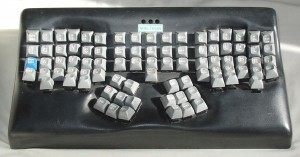
One of the most innovative keyboard designs in my opinion was one developed by a British woman named Lillian Malt. She spent years trying to improve the design of the keyboard, changing the locations of buttons to match the different lengths of individual fingers, putting the most used keys closer to the home row on the keyboard, and other improvements in efficiency. Her keyboard, named the Maltron, was first shown in 1976, and she described it in a 1977 paper. She was even written up in People Magazine the same year. Maltron never became a major manufacturer, and even though its products are still manufactured today, it has a reputation for making very expensive and not particularly well-built products (while crafting something like a wooden cabinet might benefit from a small skilled set of craftsmen, electronics usually benefit from mass-production methods). It has expanded beyond its original keyboard design to add one-handed keyboards, keyboards for quadriplegics that can be used with a mouth stick, etc. but all of its keyboards are priced beyond what most people can afford to pay for a keyboard. They’ve essentially priced themselves such that only people with serious injuries or handicaps, who require their keyboards, would buy them (and probably only with the help of insurance or an employer).
Kinesis Advantage
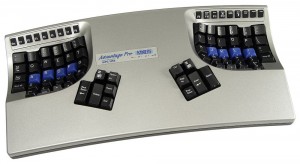
Call it inspired, influenced, whatever, some people call it ripped-off, but another company Kinesis released a very similar keyboard in the early 1990s. By 2002, Kinesis launched a USB version of their keyboard, the Kinesis Advantage, and basically that was the end of their innovation. Neither Maltron nor Kinesis have made any real changes to the design of these keyboards in over a decade.
If you read through Logitech’s annual report one thing that stands out is that wired keyboards are dropping in sales, and wireless keyboards are increasing. That makes sense, but how is it that companies trying to compete in the overall market would not consider these trends and update their products?
These keyboards are already some of the most expensive keyboards on the market, so perhaps the issue is cost. The Kinesis Advantage retails for $299. The Maltron costs £375 (roughly $622). Hard to imagine what they might cost with new technology like bluetooth and backlit keys, right?
I’ve personally used the Kinesis Advantage Pro and think it’s great. When my hands hurt from typing, it relieves my symptoms. However, I rarely use an external keyboard anymore, so it’s therefore rare for me to be able to use it.
DataHand
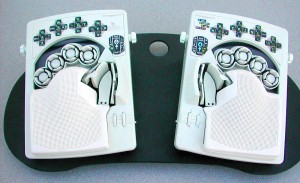
Another radical keyboard design that also reaches back about two decades, is the DataHand. No longer produced, and sought after in the second-hand market (an unopened DataHand recently sold on eBay for $2499), the DataHand took an even more radical approach to limiting hand and finger movement than the Maltron and Kinesis keyboards. The DataHand created wells for each finger, and had five buttons accessible from each finger without having to move it out of place. Keys were positioned north, south, east, west and down (really up, down, left, right and forward) and the keyboard could even be used as a mouse without moving your fingers out of place. There’s a video you can watch if you want to see the keyboard in action.
There are even someone trying to re-create the DataHand from scratch. He’s re-creating the 5-way key switches needed for each finger, and claims he’s 70% of the way there. It’s great to see something like this re-created in a public forum, but we’re still talking about a twenty-year-old design.
FrogPad
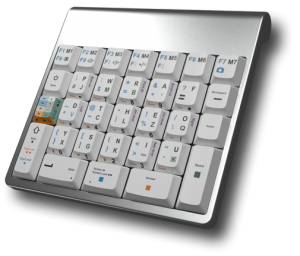
I’ll just give one more example of an interesting keyboard design, which is interesting for a number of reasons. Around 2004 Linda Marroquin introduced a one-handed keyboard called the FrogPad. The design was based on something a Japanese translator had created to allow him to hold a document in one hand and translate it using his other hand (why he didn’t just use a paper stand I don’t know). The FrogPad was a tiny USB keyboard that was operated with one hand. The keys were full size, the ability to type more letters was gained through the use of chording. Chording is using more than one key at a time to output a single character. The FrogPad went through several iterations over the years, including a Bluetooth version, a touchpad version, an iPad app, etc. The company struggled over the years, however, and the product was not always available. Recently it was announced that a new generation FrogPad, the FrogPad 2, was going to be introduced. Offering modern technology like LED key backlighting, both USB and Bluetooth, the new FrogPad will try to re-introduce the product. While this new generation keyboard was designed in concert with Linda Marroquin, it’s not clear if she is still involved in the company that is now re-introducing it.
In any case, the design dates back over a decade. Maltron is from the 1970s. Kinesis and DataHand are from the 1990s. What happened to innovation in this field?
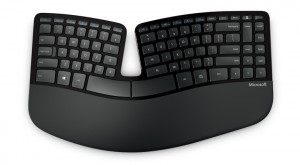
Sculpt Ergonomic
Interestingly, one of the few companies putting an effort into iterating their ergonomic keyboards is a software company – Microsoft. Microsoft’s Sculpt Ergonomic keyboard was released last year, and seems to be an evolution from earlier ergonomic keyboards that sought to keep the direction of each hand more natural (not parallel). The keys are not tactile, and there is no differentiation in distance for different fingers like the Maltron innovated, but it is a solid well thought out keyboard.
Which Switch?
Recently there have been a slew of new keyboards hitting the market whose sole innovation has been to re-introduce mechanical switches under the keys. Mechanical keys generally require more pressure to activate, and offer a tactile feel that many people prefer when typing. Kinesis understood this two decades ago when they created their first ergonomic keyboard, as they worked with keyboard switch manufacturer Cherry to create a tactile switch now called the Cherry MX Brown. For many years Kinesis was the only customer for these switches, but over time they and slight variations on them, became very popular. In a kind of retro-chic movement, keyboard companies have been introducing premium keyboards with mechanical switches that are a throw-back to the earliest computer keyboards. For an interesting look at the various Cherry Switches, used in many many keyboards on the market today, see An introduction to Cherry MX mechanical switches from the Keyboard Company.
Many companies tout how close their keyboards are to the original IBM Model M Keyboards from the 1980s, whose ‘buckling spring’ mechanical switches were considered the pinnacle of tactile keyboard technology. Interestingly, after IBM sold its computer business to China-based Lenovo, the keyboard division was sold off, and modern versions of those keyboards with the same buckling spring keys are now made in Kentucky by the company Unicomp.
Mechanical keys or not, these new keyboards are not really innovative in their design. They are a throwback to earlier keyboards, and not innovative designs to make typing easier, more comfortable, or more ergonomic.
Where does that leave us?
No doubt the rise of notebooks and tablets have shrunk the market for good ergonomic keyboards. Even though notebooks have keyboards, and there are many keyboards designed for tablets, in both cases those keyboard aspire to be thin and flat, putting other considerations to a very second-tier in their design.

The only interesting keyboard I’ve seen recently is more satire than product. It was created by a Dutch design team called Nieuwe Heren, and it’s a keyboard built into a pair of pants. They call it Beauty and the Geek. Not practical, not ergonomic, not comfortable, but interesting at least.
What interesting keyboards have you seen created in the past ten years? I do wonder what the total number of keyboards produced is today compared to twenty years ago. Sure, as a percentage of computing devices, ones that use external keyboards are a much smaller percentage than two decades ago, but there are also a lot more computer users today than there were twenty years ago. Also, considering the premium the advanced ergonomic keyboards like Maltron bring, you’d think that even as a niche, there must be room for innovation when there are companies that exist selling keyboards for more than $500.
So what innovative keyboards have I missed that have been designed in the last ten years? What keyboard do you use? Is there a keyboard you used in the past that you wish there was a modern equivalent to?
p.s. If I left your favorite ergonomic keyboard, maybe Goldtouch, SafeType, Fentek, or any one of the many other keyboard designs I apologize in advance. There is not room nor time to discuss every product in existence.

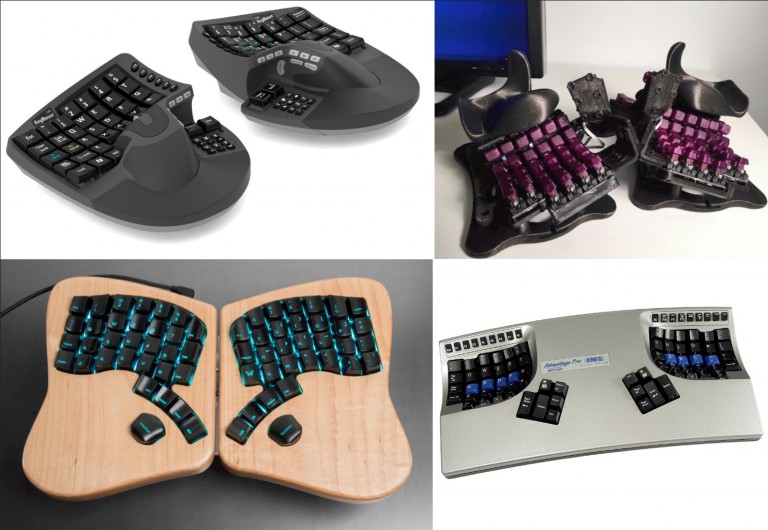
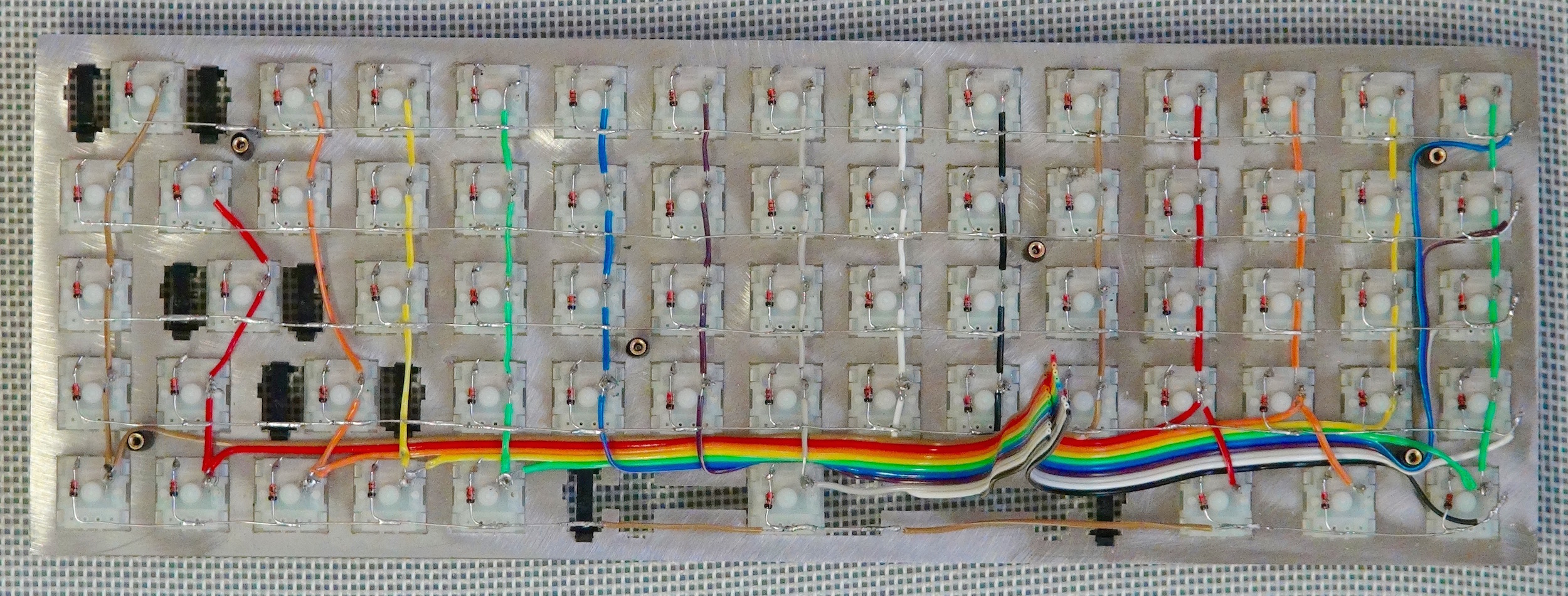
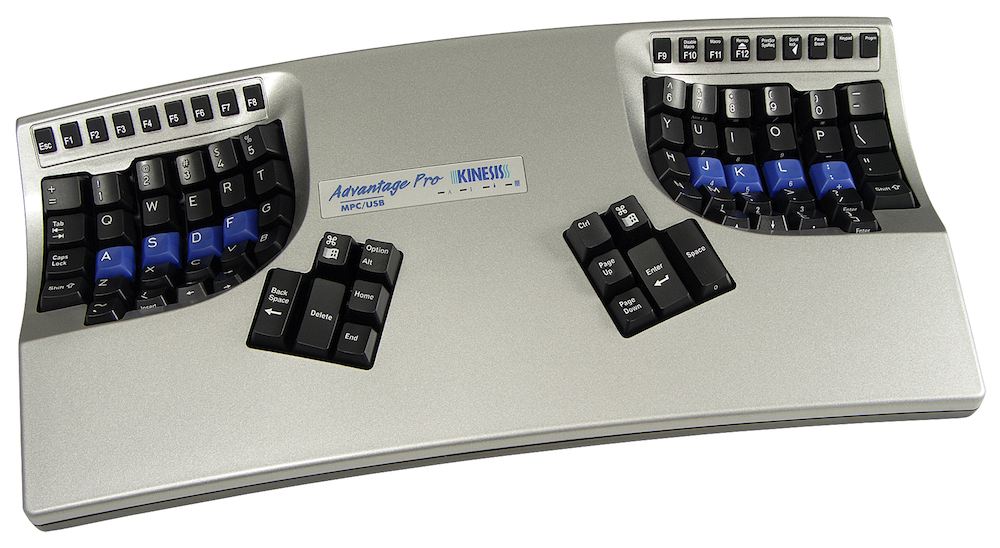
I guess the answer to your title question is that you must not be looking for them. Have you ever heard of Geekhack.org or Deskthority.net? There are entire online communities built around enthusiasm for keyboards, specifically mechanical keyboards. There is innovation happening there every day, you just have to know where to look. There is the hobbyist ErgoDox, which has sold hundreds of units through a group buy organizing site called Massdrop. Also, I wouldn’t call PFU Fujitsu’s Happy Hacking keyboard a throwback. So, innovation is happening, it just may not have reached mass market appeal quite yet.
I think the enthusiast stuff is great, but they’re not really products yet. Some of it is really interesting, but some of it is just re-hashing old designs. The ErgoDox is nice, but how is it really innovating? The Happy Hacking keyboard may not be a throwback, but it’s really just an optimized layout for a specific purpose. The design itself is nothing special.
Think about what went into designing the Maltron back in the 1970s. Look at the unique design of the DataHand. These were radical changes. Changing the layout of the keyboard or using tactile switches is not innovating. When Kinesis co-developed the Cherry MX Brown switches for their keyboard over 20 years ago, that was a form of innovating. Sticking the same switches in your keys today is not really innovating.
If anything the most interesting design I’ve seen is a current kickstarter called the King’s Assembly (https://www.kickstarter.com/projects/70308014/kings-assembly-a-computer-mouse-full-of-awesome) which is definitely a new design, although it hasn’t reached the market yet, and is thus impossible to know if it is actually an improvement. Indeed, it’s unknown if it will reach the market at all. I’ve been burned by hardware kickstarters that never delivered in the past, so it’s hard to call it a product just yet. It does have potential, however.
Hey, cousin, interesting article. Back in the 1980s, when I went back to finish college, got a job running a computer lab on campus, learned a lot I still use. Also learned to strip a keyboard down only so far or it was like trying to put teeth back in your mouth. The engineer in charge of all the labs told me I lost my [innocence] as a techie that day and laughed his a** off.
Now, when I’m home, I plug in a USB keyboard purchased from Davka for $20 or $30, with the Hebrew letters permanently imprinted on the keys, because stickers just don’t hold up. It seems that the actual Hebrew/English functionality comes from the driver, though, because I can select Hebrew using the laptop’s own keyboard as well. It’s a cheapie, but a comfortable size with more room for my arthritic fingers than the laptop’s own.
I remember in the lab, we tested a Dvorak keyboard. To me, it was a novelty, but a no-go, because I’m so used to the qwerty layout that it drove me nuts. Because this was in the early days of the PC, we had actual IBMs, and those keyboards did feel good to use. They could also emulate the typewriter click for people who still needed to hear that.
Good to hear from you (and I know who you are without the note). I always say that people should use what’s comfortable for them. Stickers definitely don’t last. When I need Hebrew I use a layout that maps to QWERTY (Reish is R, Nun is N, etc.), however, so I don’t need to remember the Israeli Hebrew layout which is very different (and I don’t need two sets of letters on my keys). I also find I’m too comfortable with QWERTY to switch to a different layout like Dvorak, although I’m open to a different layout if the keyboard itself is designed better. I don’t think just switching to Dvorak would help me very much (my typing style is fast, but not really touch).
Ditto here re typing style. Your research yielded some neat history. Will have to check out your blog generally. Be well.
Kinesis DID NOT designed an ergonomic keyboard, they just copied Maltron. Kinesis patent is about how to manufacture a cheaper ergo keyboard, not the design itself.
Kinesis asking manufacturer Cherry to create MX Brown is an unconfirmed Myth. Maltron uses MX switches since the 70’s, several Cherry keyboards use Cherry switches, a lot of POS (Point of sale) use these switches, so no, Kinesis was NOT the only customer for these switches ever.
Microsoft Sculpt is not an evolution from their earlier ergonomic keyboards; they just replaced cheap rubber domes with cheap scissor switch, and copied others by removing the numeric pad. The hole in the middle of the design is an optical illusion to pretend it is a two-piece keyboard like the Goldtouch, when in fact is just a one-piece board.
I suggest you research more before posting on your blog, you just look uninformed. There are and have been a plethora of ergo boards, including the Truly Ergonomic Keyboard, the Apple Adjustable Keyboard, and AlphaGrip amongst others that you can see at http://en.wikipedia.org/wiki/Ergonomic_keyboard
I’m not sure why you point out that Kinesis copied Maltron when that’s the first line in my paragraph on Kinesis.
Lots of companies used Cherry MX switches, but who was the first to use what came to be known as Cherry MX Browns? Maybe it is a myth, but it seems a fairly pervasive one. Indeed, if it’s a myth, it’s a myth within Kinesis itself, where an employee posted the story on Geekhack (http://geekhack.org/index.php?topic=37100.msg706886#msg706886) that the owner of Kinesis asked Cherry for a tactile low-force switch without the clicky sounds of the blues, and the brown switch was the result.
The Sculpt is an evolution from previous keyboards, but certainly not a revolution. I don’t look at it as a significant advancement in any sense, I just give it as an example of a mainstream keyboard manufacturer that is at least iterating their designs, and not sitting on the same design for decades.
Of course there are other keyboards. I point that out at the end of my article. I listed the ones I did of keyboards that were representative of earlier shifts in keyboard design that were significant. I don’t think the ones you listed were particularly different from other keyboards that have been released. There’s no point listing every keyboard that ever existed.
The dilemma with coming up with a new innovative keyboard is that if it is too unlike what people are used to, it won’t sell. Kinesis and Maltron are not known for their high volume.
I think Microsoft should get some praise for embedding at least some ergonomic aspects (tenting, hand separation,…) into their QWERTY keyboards.
The same Kinesis rep. on Geekhack whose post you linked to have also asked the community for suggestions on how to improve the Kinesis Advantage, and wireless is #1 on the wish list for many.
A new improved revision influenced by those suggestions is promised to be in progress.
I would also like to recommend that you look at the GoldTouch Go!2 Wireless. I am considering getting one of these and a Win8 tablet when it gets time to replace the laptop.
I absolutely give Microsoft praise for continuing to refine their ergo keyboards. If I had to guess, Microsoft probably puts more money into keyboard design than any other company. The good news is that today a number of factors, such as crowd funding and 3D printing for rapid prototypes, have reduced the amount of money and the risk required to release a new product into the market. Hopefully this will lead to some new designs that would never have gotten to market in the past (see my follow-up article http://trauring.org/few-interesting-keyboards/ on a few keyboards close to reaching the market).
I noticed that thread about the new Kinesis Advantage keyboard as well, but as far as I remember it’s way behind schedule. I doubt they read it, but I posted my own suggestions for how to improve it (http://trauring.org/re-design-kinesis-advantage-keyboard/).
The GoldTouch keyboard is really interesting. I like that it folds in half. Any idea what the switches are?
Pingback: A few interesting keyboards, nearly in existence... | off on a tangent
Pingback: How many keys are there on a keyboard? - off on a tangent
Pingback: Three delayed keyboards (or Four Future Keyboards) - off on a tangent